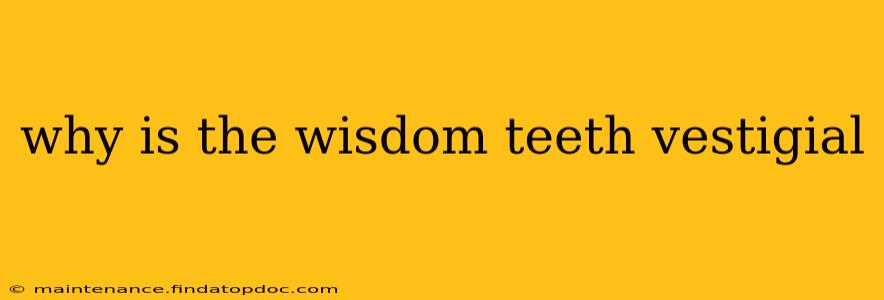Wisdom teeth, also known as third molars, are often the source of dental woes. Their problematic nature has led many to consider them vestigial—meaning they've lost most or all of their original function through evolution. But why are they considered vestigial, and what does that really mean?
This article dives deep into the reasons behind the vestigial nature of wisdom teeth, addressing common questions and misconceptions.
What Does "Vestigial" Mean?
Before we explore wisdom teeth specifically, let's define "vestigial." A vestigial structure is a biological feature that has lost all or most of its original function through evolution. These structures are often remnants of organs or tissues that were once essential to our ancestors but are no longer necessary for survival in modern humans. Think of the human appendix or the tailbone—both are considered vestigial.
Why Are Wisdom Teeth Considered Vestigial?
The prevailing theory posits that our ancestors had larger jaws and more space to accommodate three molars on each side of the mouth, including wisdom teeth. These teeth likely played a crucial role in chewing tough, fibrous foods common in their diets. However, as human diets shifted and evolved over millennia (becoming softer, more processed foods), jaw size gradually decreased.
This change in jaw size resulted in insufficient space for the third molars to erupt properly. When wisdom teeth do erupt, they often become impacted—trapped beneath the gum line or partially emerged, leading to pain, infection, and other dental problems.
This lack of sufficient space and the frequent complications associated with their eruption strongly support the argument that wisdom teeth are vestigial. They are essentially evolutionary leftovers that are no longer beneficial, and in many cases, detrimental to modern humans.
Do All Humans Have Wisdom Teeth?
No, not all humans develop wisdom teeth. Some individuals are born without the genetic predisposition to develop third molars, while others may develop them but have enough jaw space for them to erupt normally without issue. This variation highlights the ongoing evolutionary process.
Are Wisdom Teeth Always Problematic?
While wisdom teeth are often associated with problems, it's crucial to clarify that not everyone experiences issues. Some individuals have wisdom teeth that erupt normally and function without complications. However, the high percentage of cases resulting in impaction, crowding, or infection significantly strengthens the case for their vestigial status. The potential for problems outweighs the potential benefits in the vast majority of cases.
Can I Prevent Wisdom Teeth Problems?
While you cannot prevent the development of wisdom teeth, regular dental checkups are crucial for early detection of potential issues. Early intervention, such as extraction before complications arise, can significantly reduce the risk of future problems.
Why Haven't Wisdom Teeth Disappeared Entirely?
The complete disappearance of a vestigial structure is a gradual process driven by natural selection. While the trend is towards fewer people developing problem-free wisdom teeth, the genes responsible for their development haven't entirely vanished from the human genome. The relatively recent nature of the dietary shift contributing to this problem means evolution hasn’t had enough time to completely eliminate the genes that code for wisdom teeth.
Conclusion
The evidence strongly suggests that wisdom teeth are vestigial structures. Their frequent complications, linked to the reduced size of modern human jaws, highlight their lack of functional significance in contemporary humans. While not all wisdom teeth cause problems, the prevalence of issues justifies their classification as vestigial and the common practice of prophylactic removal. Understanding this evolutionary perspective can help us appreciate the complexities of human biology and the ongoing process of adaptation.
